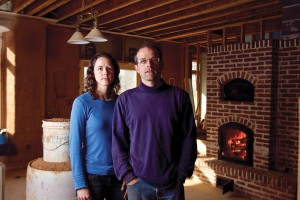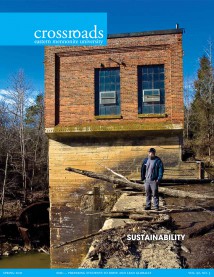
Kim ’94 and Mike ’94 Martin are living in a trailer on their land in Greencastle, Pennsylvania, during the construction of their straw bale house – its wood-burning masonry stove already works fine. A service term in Mexico partly inspired their commitment to simple living.
The house taking shape on the property of Kim and Mike Martin, both ’94 grads, in Greencastle, Pennsylvania, was largely inspired by the couple’s service term with Mennonite Central Committee in Mexico. Living in a society with a material standard of living far below that of the US middle-class has shaped many lifestyle decisions they’ve made since. In 2009, they began work on a straw bale house.
The Martins will heat their house with wood in a masonry stove, a large structure that dissipates heat throughout the day after a hot fire in the morning. The house also uses passive solar design, composting toilets, recycled lumber, plumbing to allow gray water recycling, and other features to minimize its environmental impact.
Their house is a duplex of sorts, with adjoining living quarters for Mike’s brother and sister-in-law and a shared mud and laundry room in the middle. The two families lend each other support and encouragement, sharing the work of gardening and feeding the livestock.
“Doing it in community makes it much more joyful,” Mike says.
Lynn Stoltzfus ’95 also returned from a period of service in Mexico, with Christian Peacemaker Teams, with an inspiration to incorporate sustainability into everyday life. For the past four and a half years, Lynn, his wife, Christine Forand, and their two daughters have lived in a straw bale house that is disconnected from the power grid in Durham, Ontario. The family heats and cooks with wood, uses solar panels and a wind turbine to generate electricity, and grows most of its own food in a quarter-acre garden.
The idea behind this arrangement, Lynn says, is to “withdraw support for the status quo economic system that’s built on the oppression of people in other parts of the world.”
Among the challenges of living the way they do is that Lynn and Christine have to devote significant time to tending the garden, and “simple” tasks in a normal home (e.g., adjusting the thermostat) are more time consuming (e.g., going out to the woodshed and rekindling the fire).
For Barry Kreider ’86, one of the most rewarding aspects of living in a straw bale house has been the way it has connected him to new people. People call out of the blue, asking if they can stop by to tour the home in Akron, Pennsylvania.
The Kreiders themselves did a lot of visiting and research before building their own house, which was finished in 2003. They heat with a masonry stove and have solar panels on the roof that produce twice the amount of electricity as they use. “In-law quarters” built into the home, currently home to a family from the Kreiders’ church, represent another aspect of sustainable living in the home: community.
Among the straw bale homes visited by the Kreiders was one in Keezletown, Virginia, where Alta Brubaker ’74 lives with her husband, Wayne S. Teel. Their home was finished in 2000, modeled after a Frank Lloyd Wright design. With passive solar design, solar hot water, a wood stove, and the straw bales’ exceptional insulating qualities, Alta estimates their annual heating bill is equivalent to a monthly bill in a conventional home.
After finishing college, sisters Lara Fisher ’98 and Atieno Bird, MA ’99 (Jennifer Atieno Fisher when at EMU), worked with other family members to construct a straw bale cottage as a retreat in Lewisburg, West Virginia, both for family use and for short-term rental.
